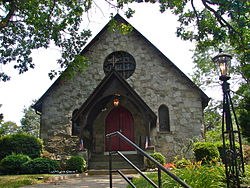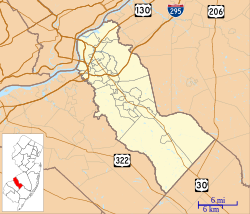
Burlington is a city situated on the banks of the Delaware River in Burlington County, in the U.S. state of New Jersey. It is a suburb of Philadelphia. As of the 2020 United States census, the city's population was 9,743, a decrease of 177 (−1.8%) from the 9,920 recorded at the 2010 census, which in turn reflected an increase of 184 (+1.9%) from the 9,736 counted in the 2000 census. The city, and all of Burlington County, is a part of the Philadelphia-Reading-Camden combined statistical area and the Delaware Valley.

Christ Church Burial Ground in Philadelphia is an important early-American cemetery. It is the final resting place of Benjamin Franklin and his wife, Deborah. Four other signers of the Declaration of Independence are buried here, Benjamin Rush, Francis Hopkinson, Joseph Hewes, and George Ross. Two additional signers of the Declaration of Independence, James Wilson and Robert Morris, are buried at Christ Church just a few blocks away.

St. Mary's Episcopal Church is a historic Episcopal parish in Burlington, Burlington County, New Jersey, United States. The original church was built in 1703. It was supplemented with a new church on adjacent land in 1854. On May 31, 1972, the new church was added to the National Register of Historic Places and on June 24, 1986, it was declared a National Historic Landmark. It is within the Burlington Historic District.
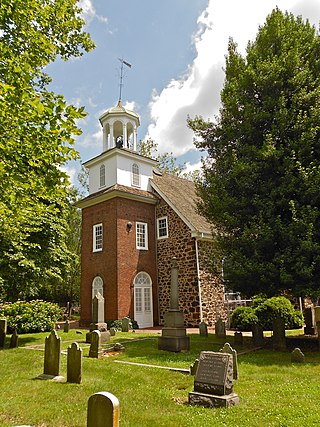
Holy Trinity Church, also known as Old Swedes, is a historic church at East 7th and Church Street in Wilmington, Delaware. It was consecrated on Trinity Sunday, June 4, 1699, by a predominantly Swedish congregation formerly of the colony of New Sweden. The church, designated a National Historic Landmark in 1961, is among the few surviving public buildings that reflect the Swedish colonial effort. The church is considered part of First State National Historical Park. The church, which is often visited by tourists, remains open for tours and religious activities.

Christ Church is an Episcopal church in the Old City neighborhood of Philadelphia. Founded in 1695 as a parish of the Church of England, it played an integral role in the founding of the Protestant Episcopal Church in the United States. In 1785, its rector, William White, became the first Presiding Bishop of the Episcopal Church.
St. John's Episcopal Church is a historic Episcopal church located at 61 Broad Street in the historic heart of Elizabeth, New Jersey. Now part of the Episcopal Diocese of New Jersey headquartered in Trenton, it was founded in 1706 by missionaries of the Society for the Propagation of the Gospel, London, England. The current building, consecrated in 1860, is in the neo-Gothic style, with a 126-foot Gothic style tower.
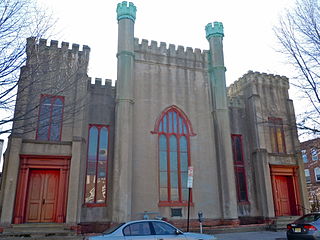
Established in 1703, St. Michael's Church in downtown Trenton, Mercer County, New Jersey, United States, is a founding parish of the Episcopal Diocese of New Jersey. Its present building located at 140 North Warren Street was built in 1747–1748, and was renovated in 1810 and 1847–1848. It was listed on the National Register of Historic Places on April 29, 1982 as St. Michael's Episcopal Church.

The Church of St. James the Less is a historic Episcopal church in Philadelphia, Pennsylvania, that was architecturally influential. As St. James-the-Less Episcopal Church, it was designated a National Historic Landmark for its Gothic Revival architecture, which influenced a generation of subsequent churches.
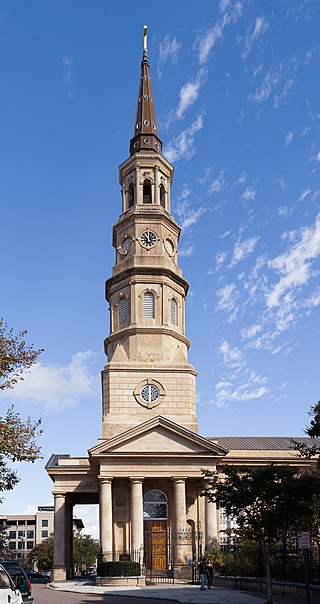
St. Philip's Church is an historic church at 142 Church Street in Charleston, South Carolina. Its National Historic Landmark description states: "Built in 1836, this stuccoed brick church features an imposing tower designed in the Wren-Gibbs tradition. Three Tuscan pedimented porticoes contribute to this design to make a building of the highest quality and sophistication." On November 7, 1973, it was added to the National Register of Historic Places and designated a National Historic Landmark.

Glendale Methodist Episcopal Church is a historic church at 615 Haddonfield-Berlin Road, at the junction with White Horse Road, in the Glendale section of Voorhees Township, Camden County, New Jersey, United States. It was added to the National Register of Historic Places on August 4, 1995 for its significance in community planning, development, and education from 1855 to 1920. At the time of its construction, the village of Glendale was impacted by the train station stop of Ashland on the Camden Atlantic Railroad. Because of the railroad, Philadelphians and shore villagers came to trade and do business.

Solomon Wesley United Methodist Church is a historic church at 291-B Davistown Road / Asyla Road in the Blackwood section of Gloucester Township, Camden County, New Jersey, United States.

Old Broad Street Presbyterian Church and Cemetery is a historic church on Broad and Lawrence Streets in Bridgeton, Cumberland County, New Jersey, United States. It was built in 1792 and added to the National Register of Historic Places in 1974. The church and cemetery are also listed on both the New Jersey Register

Mount Zion African Methodist Episcopal Church and Mount Zion Cemetery is a historic church and cemetery located at 172 Garwin Road in Woolwich Township, New Jersey, United States. The church was a stop on the Greenwich Line of the Underground Railroad through South Jersey operated by Harriet Tubman for 10 years. The church provided supplies and shelter to runaway slaves on their way to Canada from the South. The church and cemetery were part of the early 19th-century free negro settlement sponsored by Quakers known as Small Gloucester.

Trinity Church, also known as Old Swedes' Church, is a historic church on the northwest corner of Church Street and King's Highway in Swedesboro in Gloucester County, New Jersey, U.S.

St. Peter's Episcopal Church is a historic church at Rector and Gordon Streets in Perth Amboy, Middlesex County, New Jersey. It is the oldest Episcopal parish in New Jersey and contains the oldest extant gravestone in New Jersey. The church building, built from 1849 to 1852 in Gothic style, was added to the National Register of Historic Places on May 12, 1977, for its significance in religion.

Sharp Delany, was a colonel in the American Revolutionary War a legislator and the first Collector of Customs in Philadelphia, appointed by George Washington.
Chews Landing is an unincorporated community within Gloucester Township, in Camden County, in the U.S. state of New Jersey.
Houstonville is an unincorporated community in the Eagle Mills Township of Iredell County, North Carolina, United States. Houstonville is located on U.S. Route 21, 3.3 miles (5.3 km) north of Harmony. Houstonville was founded in 1789 by Christopher Houston and is the second oldest town in Iredell County after the county seat, Statesville.

Old Bridge, also known as the Historic Village of Old Bridge, is an unincorporated community located within East Brunswick in Middlesex County, in the U.S. state of New Jersey. It is on the South River, a tributary of the Raritan River. The community is named after the first bridge built here to cross the river, the South River Bridge. After other bridges were built crossing the river, it became known as the Old Bridge. The Old Bridge Historic District, encompassing much of the village, is listed on the state and national registers of historic places.

Piscatawaytown is the oldest neighborhood in Edison in Middlesex County, New Jersey. It was established in the 1660s as the original village in what was then within Piscataway. Piscatawaytown is centered around St. James Church, the Piscatawaytown Burial Ground and the Piscatawaytown Common, near the intersection of Plainfield and Woodbridge Avenues.
